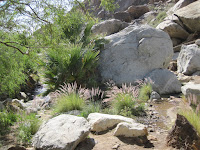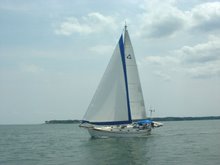Location:
Borrego Springs, California
Unfortunately, due to poor road conditions two of the three were washouts (get it? Hahahaha)
But then a short stop in Bahia de Los Angeles ended up being 5 days because it was so beautiful there and we found a great camping spot right on the beach with a palapa, complete with wonderful hosts and neighbors.
One last excellent Mexican breakfast just south of Tecate, and, after an hour and a quarter of crawling in the line to the border station, we were passed through easily and were back home in the USA. A nice end to a wonderful visit. Adios y gracias, Baja California!
We'd heard that the wildflowers in California's Anzo-Borrego Desert State Park were awesome this year, and, since we were already nearby, decided to spend 3 or 4 days hiking around and playing tourist.
We got to visit a slot canyon, saw many beautiful cactus and wildflower blooms, and a most unexpected and pleasant surprise, hung out with some avid birders to watch some of the Swainson's Hawk migration. These hawks migrate from as far south as Argentina to as far north as Alaska and back again every year. It turns out that Borrego Springs is one of their favorite stops along the way – the valley has the largest spring concentration of migrating Swainson's hawks in North America.
One very important food for the hawks is the springtime abundance of sphinx moth caterpillars. Yum!
This was taken on a trail that wound up a canyon and ended at a Palm oasis. If you look closely you can see the water, we haven't seen much of that in the last few months

We attended two evening hawk migration viewing sessions and one pretty much non-event morning count (only some of the birds migrated that day, and those few waited until 1:30 in the afternoon - we'd lost interest and left hours earlier.)
Not being birders, and not really planning to become birders, we came more to watch the watchers than the birds. Like any group of people with a keen interest in something, birders can get a bit “geeky” when talking among themselves. There were times we had absolutely no idea what they were talking about – sort of like our first ham radio club meeting back before we took off on Rachel.
But, not only did we find them gentle and entertaining, we also inadvertently learned a great deal during these sessions. For example, did you know that during a migration hawks can “stream”, “kettle”, “tornado”, and form a “migratory bow”? Or that there are three primary genetic types in the Swainson's Hawk population – light, medium, and dark “morphs”?
Many hawks didn't leave that day, so there were something like 400 or 500 “locals” who had spent the day there, and more new arrivals coming in. Hopes were raised for a good count in the morning. Only 2 mornings earlier they'd counted 1400 birds as they left to migrate further north!
We ended up really enjoying ourselves. The “hawkaholics” were very welcoming and sooo enthusiastic! Here are some snippets of conversation that took place while we were there during our first evening viewing”:
“Oh, my goodness!” (repeated nearly continuously through the evening from one group or another)
“There must be 400 of them. Do you think there are 400? Oh, maybe it's 450. I think it's got to be at least 450. Or even 500.”
“Oh! Look at them rise. Something spooked them. I hope it wasn't any of our people!”
“Oh! They're kettling.”
“Ooh – I think they're going to form a tornado!”
“This is a once in a lifetime opportunity! You could do this every day for years and not see this!”
“Oh, maybe I'll go ahead and cancel my Dr.'s appointment tomorrow morning so I can help with the count. This is just too exciting!”
“Oh! Is this who I think it is pulling up? ANNE! ANNE! Drop whatever you're doing and get up here right now! You've got to see this!”
“I'm going to try and count them.” <starts clicking one of those silver hand held counters – clickety clicky clicky clickety clickety click click click....> “Oh, I just can't keep up!”
At this point we both say “I think you already counted that one.” Silence.
“Those hawks are coming from the potato fields. The insecticides they use kill the insects and the hawks feed on them. It's awful. Did you know they spray 26 different chemicals on potatoes? If you're only going to eat one organic vegetable, let it be potatoes.“
A lenticular cloud, in all our years of sailing we've never seen one of these before
 Another pleasant surprise in Borrego Springs was the art. We were treated to a great 2 day Art Show at the town center, and discovered that the town sports 130 full sized steel welded sculptures, created by Ricardo Breceda, dotted around. They are inspired by creatures that roamed this same desert, the piece de resitance being a 350 foot long serpent.
Another pleasant surprise in Borrego Springs was the art. We were treated to a great 2 day Art Show at the town center, and discovered that the town sports 130 full sized steel welded sculptures, created by Ricardo Breceda, dotted around. They are inspired by creatures that roamed this same desert, the piece de resitance being a 350 foot long serpent.
































